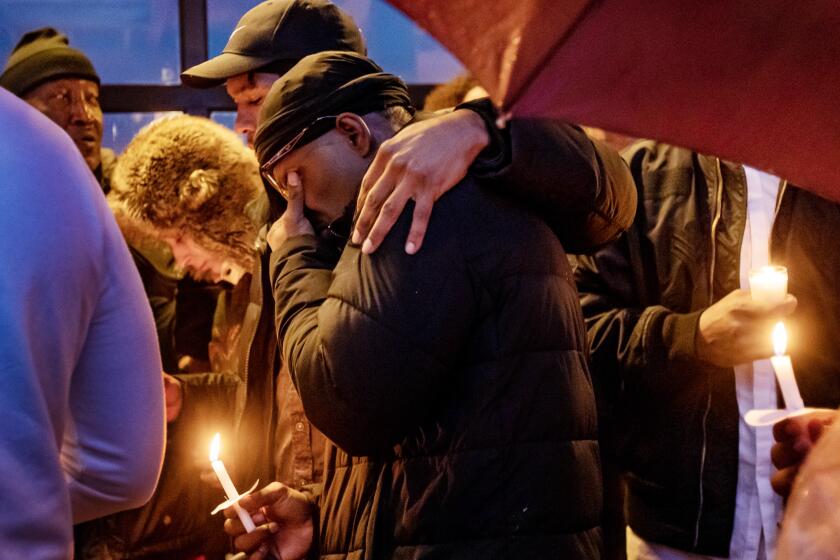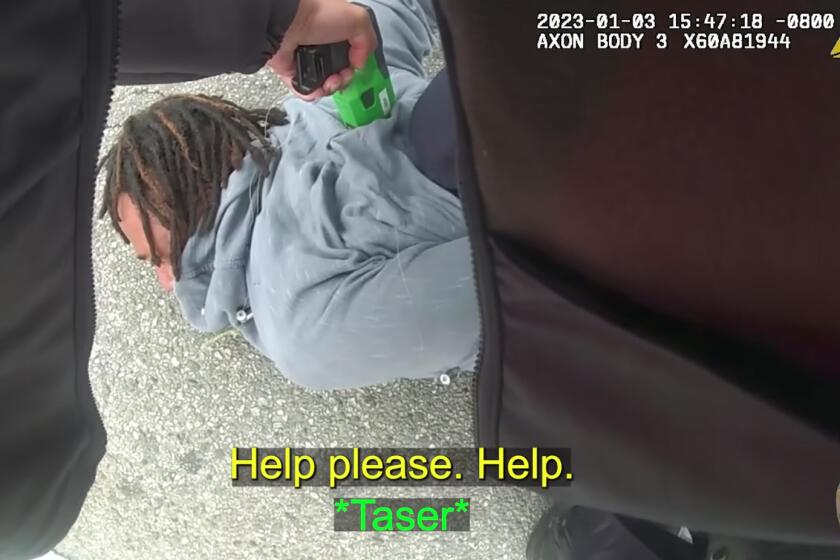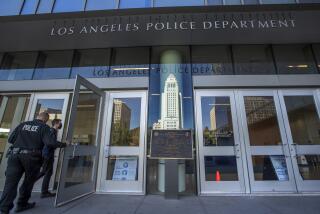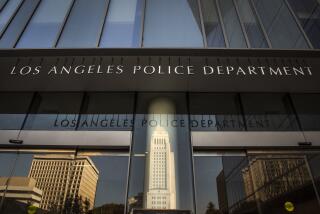LAPD officers involved in Keenan Anderson death found out of policy
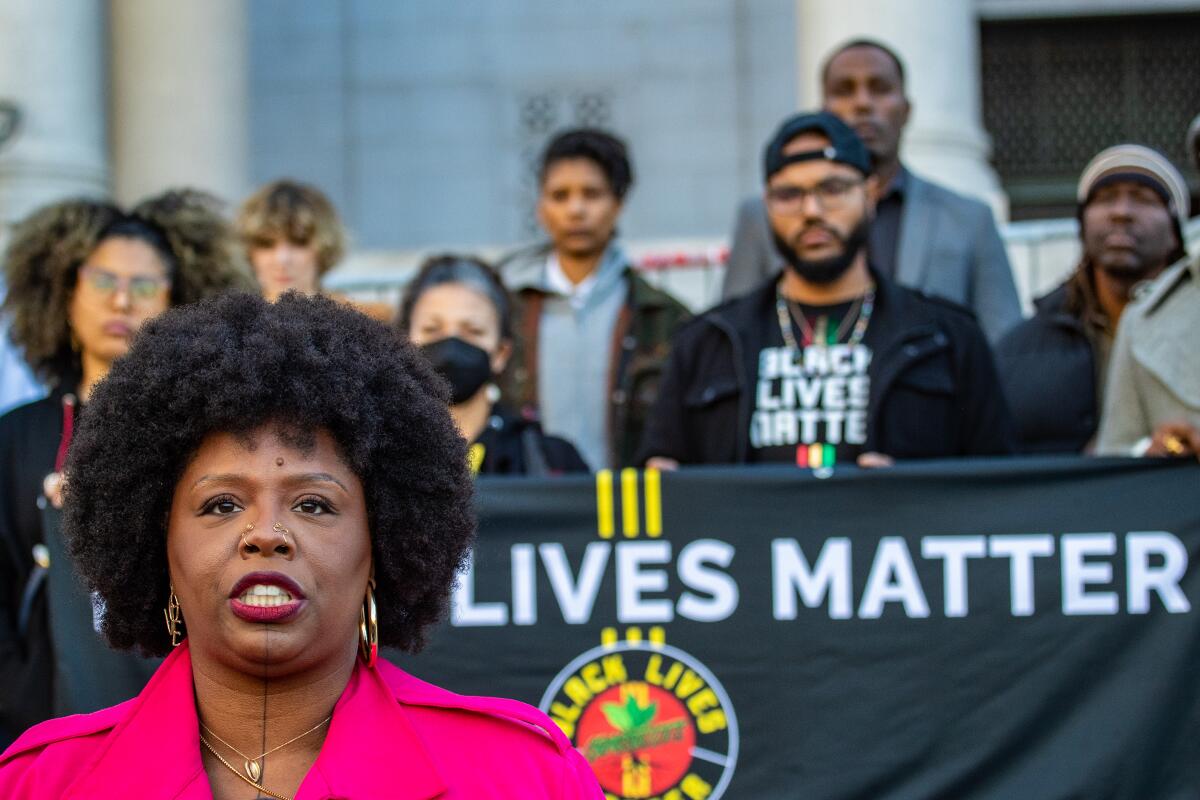
Several Los Angeles police officers broke with department policy in the arrest of Keenan Anderson, whose death after a traffic stop in January reignited debates about the suitability of police for dealing with people in distress, the Police Commission ruled.
Although not unanimous, the commission Tuesday found that officers deviated from LAPD policy on multiple occasions when they restrained and shocked the 31-year-old teacher and father with a Taser while trying to take him into custody.
Officers struggled with Keenan Anderson for several minutes, using a Taser, their body weight, “firm grips and joint locks.”
The civilian oversight panel generally agreed with the conclusions of LAPD Chief Michel Moore and an internal department review board, which itself was split on several policy questions.
Moore and police commissioners concluded that one of the officers continued to use a stun gun on Anderson, a Black man, even after he no longer posed an immediate threat. Moore and the commission also ruled that, whether inadvertently or not, two of the officers did not have cause to hold Anderson down by the neck. Under the department’s policy, such contact to a person’s neck is considered deadly force.
Anderson’s case garnered international attention, in part because he was a cousin of Patrisse Cullors, a co-founder of the Black Lives Matter Global Network. Los Angeles Mayor Karen Bass strongly condemned the incident, which happened weeks after she took office and sparked calls for changes to police policies related to traffic enforcement and the use of stun guns.
It also added kindling to a fiery debate about how police interact with people in crisis after a string of high-profile deadly encounters in recent years.
Veteran civil rights attorney Carl Douglas, who filed a wrongful death lawsuit on behalf of Anderson’s family, called Tuesday’s ruling a rare but welcome decision from an oversight body he said too often signs off on police misbehavior. The finding was “one small step toward justice,” he said.
The family of Keenan Anderson is suing the Los Angeles Police Department, alleging its officers used excessive force when they tasered the high school teacher during a traffic stop in January.
“However, we are mindful that this fight is not over. The city is going to be defended vigorously by the city attorney as they do in virtually every case,” Douglas said Wednesday, pointing out that the city has already filed motions denying any responsibility for Anderson’s death. “We are heartened that the commission saw the decision to Taser Mr. Anderson as an abomination. They don’t call it an abomination, but I can.”
What the body camera footage captured was the lack of training for officers on when Taser use is appropriate, Douglas said, adding that officers often misinterpret a person squirming as a form of resistance that justifies the device’s use.
Douglas joined about two dozen activists and members of Anderson’s family who held a news conference before Tuesday’s Police Commission meeting, demanding the officers involved be held accountable. Afterward, the group appealed directly to the commissioners in what became an emotionally charged meeting.
The commission’s ruling was denounced by the Los Angeles Police Protective League, which represents the city’s rank-and-file officers.
“We strongly disagree with these politically influenced findings, each responding officer acted responsibly in dealing with Mr. Anderson who was high on cocaine and ran into traffic after fleeing a car accident he caused,” the league’s board of directors said in a statement to The Times on Wednesday.
“The coroner confirmed he was not tased but rather drive-stunned when he refused to follow simple directions while in the middle of a busy street,” the board wrote. “Mr. Anderson and Mr. Anderson alone was responsible for what occurred.”
The encounter that ended with Anderson’s death began sometime before 3:30 p.m. on Jan. 3 when Joshua Coombs, a motorcycle officer assigned to the West Traffic Division, responded to what the L.A. Police Department referred to at the time as a “felony hit-and-run” car crash at Venice and Lincoln boulevards.
Coombs encountered Anderson darting on foot through traffic in apparent distress and ordered Anderson to sit on a street corner. Anderson complied for some time, but then took off running, yelling that he was fearful for his safety.
Coombs followed him, as did Officers Jaime Fuentes and Rasheen Ford, who had seen the incident unfold as they drove past in their squad car. The officers eventually caught up to Anderson and pinned him to the ground, as he resisted their efforts to put him on his stomach and handcuff him. They were eventually joined by two other officers, Christopher Walters and Stephen Feldman.
The commission reviewed the case during a closed-door session of its regular meeting, which was was briefly interrupted when commission President Erroll Southers ordered the room cleared because of disruptions in the audience.
Much of the criticism of the police response centered on Fuentes discharging his Taser six times in the span of 42 seconds.
Moore concluded that only the last two Taser deployments were out of policy, but was overruled by the commission, which has final say and deemed all of the deployments out of policy.
A department force review board faulted Fuentes for his final two Taser uses, delivered as other officers used their body weight and arm holds to control Anderson. Fuentes, a patrol officer in Pacific Division, told internal investigators that he used the so-called drive stun function, in which the device is pressed directly against someone’s skin rather than fired from a distance, to prevent the incident from escalating further. Fuentes said he continued shocking Anderson because he wouldn’t stop resisting.
The ruling wasn’t unanimous. The majority of the board said that, although Anderson was still pulling away from the officers, he didn’t present a threat to them and appeared instead to be starting to comply with their commands.
The majority noted that Fuentes admitted in his department interview to using the drive-stun mode for pain compliance, against department policy, and said it would have preferred that he had reassessed the situation and switched “to a different force option after the third TASER deployment.”
Several board members argued that the first four stuns were in compliance because the officers believed they could still be harmed because of Anderson’s continued resistance.
Moore wrote in his report that, in making his decision, he considered that “Anderson was violently resisting the officers’ attempts to take him into custody.”
Videos released this week of a teacher who died after Los Angeles police discharged a Taser on him at least six times on a Venice street raise serious concerns about the officers’ tactics, law enforcement experts who reviewed the tapes said.
“I noted the use of the TASER to be effective in assisting officers to take control of Anderson,” Moore wrote. “As it pertains to TASER activation five and six, I opined the officers had sufficient control of Anderson and that his level of resistance, while still ongoing, did not justify the use of a TASER as a reasonable force option.”
During the final activation, Fuentes told investigators, he saw Anderson tense up, which he interpreted as an attempt to prevent officers from handcuffing him.
Anderson was taken to a hospital, where he later died.
Last month, the department announced it would soon start testing a new generation of Tasers with greater range that would preclude officers from having to use higher levels of force against uncooperative people. The eventual switch to the next-generation Taser 10 model comes on the heels of changes in the department’s Taser policy, including barring officers from using the drive stun function.
The officers’ tactical decisions were scrutinized almost from the onset. Anderson’s family, some elected officials and police watchdogs decried what they saw as an overly aggressive response by police against someone who was disoriented and needed care after being involved in a traffic collision.
Several policing experts who reviewed video for The Times of the Jan. 3 incident — from cameras worn by officers — previously said that the amount of force used by the officers seemed excessive given Anderson’s actions and that their tactics appeared haphazard.
An autopsy by the L.A. County coroner’s office later identified an enlarged heart and cocaine use as the causes of death, and did not rule it a homicide. Whether his death was natural, an accident or a homicide remains undetermined, according to the coroner’s website. Anderson’s family has disputed the report’s findings, contending that it deflected blame from the police.
Keenan Anderson’s family is planning to file a lawsuit against the city of L.A. before the end of the month, according to the family’s attorney Carl Douglas.
During their investigation, detectives from the LAPD’s force investigations division slowed down footage of the encounter and counted nine times in which Fuentes and Ford made contact with Anderson’s neck during the struggle. Both officers denied applying pressure or otherwise restricting Anderson’s ability to breathe.
At one point in a video of the encounter, Anderson is lying on the pavement and struggling with officers when he yelled out, “They are trying to kill me. Kilo tried to kill me.” After he was told to stop struggling, video showed Ford’s right hand on the side of Anderson’s jaw, with his thumb apparently near Anderson’s neck, the report says.
With a 3-2 vote, commissioners also found fault with officers for failing to put Anderson “in a recovery position as soon as practical.”
After days of mounting public pressure, Moore took the rare step of releasing additional footage from the encounter, which showed a distraught Anderson crying out for help as multiple officers held him down. Eventually, he was handcuffed and hobbled at his ankles before paramedics take him away.
Anderson’s death also galvanized a push for removing police from responding to minor traffic collisions, as well as to stop them from pulling over motorists for traffic violations, arguing that communities of color have historically borne the brunt of such enforcement. Instead, they said, such tasks could be handled by unarmed civilians.
Melina Abdullah, co-founder of Black Lives Matter-Los Angeles and a professor at Cal State L.A., said she was heartened by the commission’s ruling, even if it was a somewhat hollow “victory” since it wouldn’t bring Anderson back.
“Justice for Keenan Anderson would mean that he were there to raise his child, that he was there to continue to be a model for his brothers, that he was there to be a model teacher,” Abdullah said. “But justice in his name looks like accountability, making sure that the cops who killed him are held accountable.”
More to Read
Sign up for Essential California
The most important California stories and recommendations in your inbox every morning.
You may occasionally receive promotional content from the Los Angeles Times.
